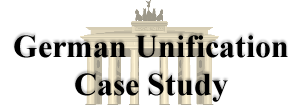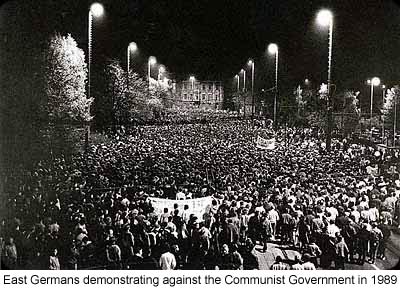
Introduction
Home
Introduction
Historical Background
The
Discussion
Goals &
Issues
Characters
Teacher's
Guide
Index
III. What is the situation at the time of German unification?
After the Iron Curtain opens in November 1989 and the West German mark is introduced into East Germany in June 1990, the real work on unification begins. Forty years of central planning and Soviet-style industrialism has left the former GDR in shambles. Nonetheless, the people of the GDR had a standard of living better than that of the Soviet Union and rebuilt their country after the war without money from the Marshall Plan like the West. The GDR grows into one of the world's larger economic powers.
When the currency of the GDR is discontinued and replaced with West German marks, East Germans are ecstatic. While the exchange rate is 1:1 for the first few thousand marks, after that it drops to 2:1 and most East Germans see their life savings slashed. East Germans find themselves plunged into a capitalist economic and social order in which even their small salaries make their noncompetitive businesses unprofitable. (productivity < salary)
One of the major players in the East is the Treuhand, a semi-governmental agency which is to restructure the unwieldy industrial organization of the GDR into private ownership. A major obstacle to privatization is the uncompetitiveness of many East German companies. Companies which cannot be sold to private investors are taken over by the Truehand itself, which adds to the agency's operating costs. Meanwhile, East Germans, who are experiencing growing unemployment, have to take care of basic necessities which were previously provided by the state: child care, health insurance, housing, etc. Granted, the quality of health care may have been better in the West, but the system of health care in the East had almost universal coverage unlike the West's single payer system. People in the East now have access to a world which was previously shut off to them. They can now travel wherever they want and buy whatever they want, provided they can afford it. This means that in the years following unification there is an initial consumer boom, with East Germans buying West German production. Easterners express 40 years of pent-up consumerism in just a few years. However, this initial boost to the economy cannot last.
Some of the contradictory sentiments created in the economic sphere are mirrored in the political sphere. East Germans are euphoric at a chance for self-governance, and many social movements arise which then turn into parties: Neues Forum is one of the more well-known. However, ultimately Easterners, who only form one-fifth of the entire German population, have to join and vote for Western parties if they want a voice. The power structure of the parties, even in the Eastern states, is controlled by transplanted West Germans. Remembering the Communist Party, most East Germans do not become members of any party.
In general, West Germans want to keep the political, economic and social costs of unification manageable, rebuilding the East while not endangering the high standard of living in the West. East Germans want to keep the social costs of unification, especially unemployment, manageable. This would require massive amounts of money to be transferred from public and private sources for investment in the East. Politicians and political parties have to make these goals acceptable to both East and West Germans, which is an extremely difficult task.
<< Previous Next >>
Home - Introduction - Historical Background - The Discussion
Goals & Issues - Characters - Teacher's Guide - Index
Goals & Issues - Characters - Teacher's Guide - Index

Foothill College, 12345 El Monte Road, Los Altos Hills, CA 94022-4599
News & Info - Apply & Register - Degrees & Programs - Catalog & Schedule - Student Services
